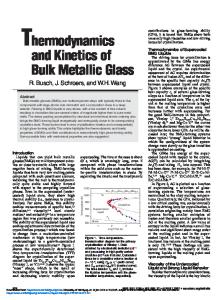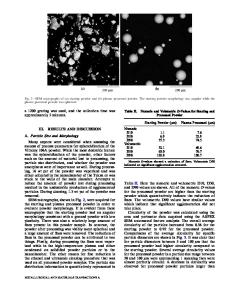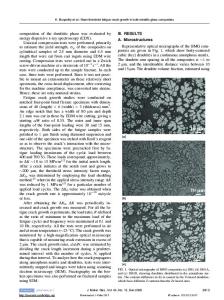Bulk Metallic Glass Foam Achieves High Ductility
- PDF / 1,040,958 Bytes
- 2 Pages / 612 x 792 pts (letter) Page_size
- 50 Downloads / 347 Views
Fe/Si nanoparticle acts as a “seed” and the Si filaments grow from the Fe/Si nanoparticle surface. This approach produced wires with a distribution of diameters ranging from 8–40 nm. In order to produce smaller-diameter wires, the researchers developed a post-synthesis approach. They used oxidation at elevated temperature to diffuse oxygen radially inward and shrink the Si crystalline core. Fractions were then separated according to the wire diameter using centrifugal separation. Using this method, the researchers produced a series of four crystalline Si nanowire samples whose most probable diameters were 4.5 ± 0.2 nm, 6.5 ± 0.3 nm, 9.5 ± 0.3 nm, and 23.1 ± 0.7 nm. The researchers probed the phonon bands in these nanowires using Raman spectroscopy at low enough laser intensity that temperature broadening was not a factor. Comparison of the Raman spectra of these Si nanowires showed that with decreasing diameter, the first-order Raman band at ~520 cm –1 develops a noticeable asymmetry to lower frequency, and the peak position downshifts. The researchers analyzed their results based on an asymmetric line-shape model developed by Richter with an adjustable parameter (α) added to the theory that defines the width of the Gaussian phononconfinement function. The researchers found that this parameter is not sensitive to diameter over the 4–25 nm range if they took into account the measured diameter distribution. This result is contradictory to the large range of reported α values. While attributing the difference to a variety of unknown conditions, the researchers said that the thickness and nature of the oxide coating on the wire might also impact the phonon confinement. That is, they said, the phonon in the crystalline core of the nanowire has to decay into phonons in the oxide shell. Therefore, the researchers suggested future experiments on hydrogenterminated Si nanowires to see how hydrogen termination affects the value of the confinement parameter. TAO XU
Bulk Metallic Glass Foam Achieves High Ductility Metallic foams are currently used as ultralight structural materials. Bulk metallic glasses (BMGs) show exceptional strength and elasticity, in addition to other favorable properties, rendering them also useful for structural applications and potentially for biocompatible implants. A.H. Brothers and D.C. Dunand of Northwestern University considered, then, whether BMG foams offer unique opportunities in engineering structures or bioMRS BULLETIN • VOLUME 30 • APRIL 2005
medical implants. They have found that Vit106 (Zr 57Nb 5Cu 15.4Ni 12.6Al 10) foam shows compressive properties not unlike ductile aluminum foam, despite a lack of ductility in monolithic Vit106. Furthermore, Vit106 contains neither precious metals nor toxic beryllium, and shows biocompatibility. As reported in the February 18 issue of Advanced Materials (p. 484, DOI: 10.1002/ adma.200400897), the researchers produced samples by crushing optical-grade BaF2 and sieving it to produce and select 215–220 µm particles. These were then packed into graphite c
Data Loading...











